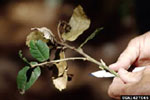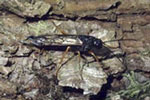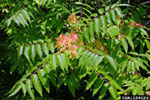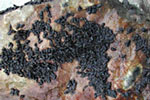- Forest Service Home
- Invasive Species
US Forest Service
1400 Independence Ave., SW
Washington DC 20250-0003
Policy and AuthoritiesForest Service Authorities for Invasive Species Management \1The Forest Service has many unique characteristics and authorities to enable it to play a major role in the fight against invasive species. Many of these authorities also apply to other Forest Service management activities which do not focus strictly on invasive species management, such as our authority to manage rangelands, conduct research, or enforce public use activities. In addition to these, invasive species are regulated and/or managed through a variety of statutes administered by the States such as State noxious weeds or animal pest species laws and the Forest Service cooperates with the States to implement those. Other Federal agencies also administer laws such as the Lacey Act, the Plant Protection Act, the Animal Damage Control Act, the Federal Seed Act, the Nonindigenous Aquatic Nuisance Prevention and Control Act, and the Alien Species Prevention and Enforcement Act to address invasive species issues. The USDA Forest Service works cooperatively with various stakeholders to implement these authorities on as appropriate. The following orders or statutes are the primary authorities to allow the Forest Service to conduct invasive species management activities to meet resource management goals and objectives. The Organic Administration Act (16 U.S.C. 551)The USDA's authority to make rules and regulations protecting National Forests is set forth in section 1 of the Organic Administration Act (16 U.S.C. 551). This provision provides broad authority to protect National Forests from "destruction by fire and depredations" and to issue regulations "as will insure the objects of such reservation, namely to regulate their occupancy and use and to preserve the forest thereon from destruction." To the extent that the use of lands adjacent to federally owned land is posing a threat to the Federal resources, the Supreme Court has construed the powers of the Federal Government to prohibit such private activities. United States v. Alford, 274 U.S. 264 (1927). To the extent that invasive species on adjacent private lands threaten public land, the common law concept may be interpreted to allow the Federal Government to abate such infestations.Multiple-Use Sustained-Yield Act of 1960 (MUSY, 16 U.S.C. 528-531) USDA manages National Forests for multiple uses under the Multiple-Use Sustained-Yield Act of 1960 (MUSY, 16 U.S.C. 528-531). MUSY provides in part A that "the national forests are established and shall be administered for outdoor recreations, range, timber, watershed, and wildlife and fish purposes" (16 U.S.C. 528). Forest and Rangeland Renewable Resources Planning Act of 1974, as amended by National Forest Management Act (16 U.S.C. 1604)The Forest and Rangeland Renewable Resources Research Act of 1978 is the Department of Agriculture's primary authority to conduct research activities, including research relating to invasive species. The Act contains expansive authority to conduct research and technology development on, and with applications for, all U.S. lands related to the protection, conservation, and sustainable use of natural resources. The Act also authorizes competitive grants to conduct research, and authorizes cooperative agreements with university, industry, and other partners as needed to complement national program needs. Federal Noxious Weed Act of 1974 (7 U.S.C. 2814)Although the Plant Protection Act superseded and repealed most of the Federal Noxious Weed Act of 1974 (FNWA), it left intact section 15 of the act, "Management of undesirable plants on Federal lands" (7 U.S.C. 2814). Section 15 of the FNWA requires Federal land management agencies to develop and establish a management program for control of undesirable plants that are classified under State or Federal law as undesirable, noxious, harmful, injurious, or poisonous, on Federal lands under the agency's jurisdiction (7 U.S.C. 2814(a)). The Act also requires the Federal land management agencies to enter into cooperative agreements to coordinate the management of undesirable plant species on Federal lands where similar programs are being implemented on State and private lands in the same area (7 U.S.C. 2814(c)). The Secretaries of Agriculture and the Interior must coordinate their respective control, research, and educational efforts relating to noxious weeds (7 U.S.C. 2814(f)). USDA's Departmental Regulation 9500-10 sets forth the Departmental policy relating to the management and coordination of noxious weeds activities among the agencies within USDA and other entities. Public Rangelands Improvement Act of 1978; and Federal Land Policy and Management Act of 1976Several statutes provide funding for rangeland rehabilitation and range improvements on public rangelands, including activities designed to control or manage invasive plants. Section 5 of the Public Rangelands Improvement Act of 1978 (43 U.S.C. 1904(c)) authorizes funding for on-the-ground rangeland rehabilitation and range improvements on some of the rangelands managed by the Forest Service. Additionally, range betterment funds, provided under section 401 of the Federal Land Policy and Management Act of 1976 (43 U.S.C. 1751), can be used for variety of range rehabilitation and improvement activities, specifically including weed control, on certain National Forest System rangelands. The Act of April 24, 1950, pertaining to range improvements, states that of the moneys received from grazing fees, a portion can be used for the "eradication of poisonous plants and noxious weeds in order to protect or improve the future productivity of the range" (16 U.S.C. 580(h)). Cooperative Forestry Assistance Act of 1978Under cooperative authorities, the Secretary of Agriculture may assist other Federal, State, and private entities in controlling and managing invasive species on other Federal lands and non-federal lands. The Secretary's primary cooperative authority for invasive species is section 8 of the Cooperative Forestry Assistance Act of 1978 (16 U.S.C. 2104). Section 8(b) authorizes the Secretary of Agriculture to conduct activities and provide technical assistance relating to insect infestations and disease conditions affecting trees on National Forest System lands, on other Federal lands (in cooperation with other Federal Departments) and on non-Federal lands (in cooperation with State officials, other entities, or individuals). These activities include in part: conducting surveys to detect and appraise insect infestation and disease conditions; determining biological, chemical, and mechanical measures necessary to prevent, retard, control or suppress incipient, potential, threatening, or emergency insect infestations and disease conditions affecting trees; planning, organizing, directing, and performance measures the Secretary determines necessary to prevent, retard, control, or suppress incipient, potential, threatening, or emergency insect infestations and disease epidemics affecting trees; and providing technical assistance to maintain healthy forests and manage the use of pesticides (16 U.S.C. 2104(b)). Section 8(g) of the Act (16 U.S.C. 2104(g)) also authorizes the Secretary to provide financial assistance through the Forest Service to State entities and private forestry or other organizations to monitor forest health and protect forest lands. The Cooperative Forestry Assistance Act of 1978 as amended by the Federal Agriculture Improvement and Reform Act of 1996 Subtitle G Sect. 373, gives authority to provide support for good forest management practices, including financial assistance to maintain healthy timber ecosystem to prevent incursion of invasive species, on privately owned non-industrial forestlands. Hawaii Tropical Forest Recovery ActSection 3 of the Hawaii Tropical Forest Recovery Act (16 U.S.C. 4502(a)) authorizes the USDA's Forest Service to provide assistance relating to invasive plants species to State officials, Federal agencies, and various other private entities in States with tropical forests. Statutes Related to RestorationRestoration efforts following control of invasive species are authorized, and limited, by the same legal authorities that address the control and management of invasive species on National Forest System lands. The Forest Service lacks specific authority to provide technical and financial assistance to State and private entities relating to these types of restoration efforts. In limited circumstances where the introduction of invasive species into National Forest lands was the result of negligence that could be established in a civil judgment, there is authority for the Secretary to use the proceeds from any damage award or settlement for "rehabilitation work" (See 16 U.S.C. 579(c)). Forest and Rangeland Renewable Resources Research Act of 1978The Forest and Rangeland Renewable Resources Research Act of 1978 is the Department of Agriculture's primary authority to conduct research activities, including research relating to invasive species. The Act contains expansive authority to conduct research and technology development on, and with applications for, all U.S. lands related to the protection, conservation, and sustainable use of natural resources. The Act also authorizes competitive grants to conduct research, and authorizes cooperative agreements with university, industry, and other partners as needed to complement national program needs. International Forestry Cooperation Act of 1990Under section 602(b) of the International Forestry Cooperation Act of 1990 (16 U.S.C. 4501(b)), the Secretary may, in support of forestry and related natural resource activities outside the United States and its territories and possessions, provide assistance for the prevention and control of insects, diseases, and other damaging agents. Under these authorities, and others the USDA's Forest Service delivers invasive species research and development products for vegetation management and protection; wildlife, fish, water and air sciences; resource valuation and use; and inventory and monitoring. The Forest Service Research & Development program addresses all aspects of that agency's invasive species program activities. The Forest Service's research authorities provide for the Service to conduct prevention, rapid response, control, and management activities related to invasive species and to restore areas affected by invasive species. National Environmental Policy Act (42 U.S.C. 4231 et seq.)Compliance with the National Environmental Policy Act (NEPA) can serve to identify actions that are likely to affect invasive species or be affected by them. The rationale behind the NEPA process - that agencies should be fully informed of the consequences of their actions before making a decision - is especially important when dealing with an issue like invasive species, where problems are often unanticipated side effects of otherwise desirable actions. Analysis and interagency, intergovernmental, and public review and comment that identify potential problems with invasive species for a particular proposed action may also yield ideas for alternative methods of approaching an issue or other forms of mitigation. Invasive Species Executive Order 13112 of February 3, 1999Directs federal agencies to use relevant programs and authorities to: a. Prevent the introduction of invasive species; b. Detect and respond rapidly to and control populations of such species in a cost-effective and environmentally sound manner; c. Monitor invasive species populations accurately and reliably; d. Provide for restoration of native species and habitat conditions in ecosystems that have been invaded; e. Conduct research on invasive species and develop technologies to prevent introduction and provide for environmentally sound control of invasive species; and f. Promote public education on invasive species and the means to address them; and g. Not authorize, fund, or carry out actions that it believes are likely to cause or promote the introduction or spread of invasive species in the United States or elsewhere unless, pursuant to guidelines that it has prescribed, the agency has determined and made public its determination that the benefits of such actions clearly outweigh the potential harm caused by invasive species; and that all feasible and prudent measures to minimize risk of harm will be taken in conjunction with the actions. The Executive Order 13112 further requires federal agencies to pursue the duties set forth in this section in consultation with the National Invasive Species Council, consistent with the National Invasive Species Management Plan and in cooperation with stakeholders, as appropriate, and, as approved by the Department of State, when working with international organizations and foreign nations. 1/ For additional clarification or statutes, please see “Principle Laws Relating to Forest Service Activities”; US Department of Agriculture, Forest Service, 1993. Government Printing Office. |
Last modified: Friday, 24-Mar-2006 13:40:13 EDT



